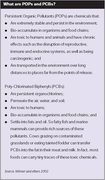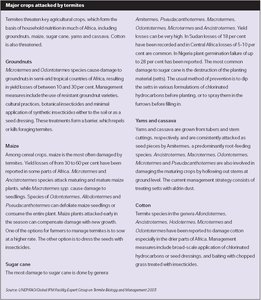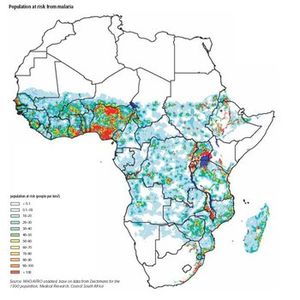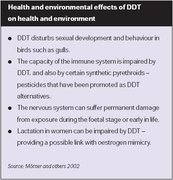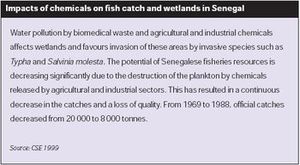Chemical use in Africa: opportunities and risks
Contents
- 1 Introduction
- 2 Industry provides new opportunities for employment
- 3 Investing in research and development
- 4 Agriculture
- 5 Termites threaten infrastructure and food security
- 6 Control of diseases
- 7 Freshwater systems and access to safe water
- 8 Chemical exposure
- 9 Natural resource use and adverse environmental impacts
- 10 Impacts on biodiversity
- 11 Further reading
Introduction
The chemicals industry and its products have many potential benefits particularly related to improving and sustaining human capital through new opportunities for employment, improved health and nutrition. At the same time the production and use of chemicals creates risks at all stages of their life cycle. The generation and release of intentionally and unintentionally produced chemicals, has contributed to environmental contamination and degradation at multiple levels – local, regional and global – and in many instances the impact will continue to be felt for generations. (Chemical use in Africa: opportunities and risks)
Industry provides new opportunities for employment
Growth in the industrial sector creates new opportunities for employment and can also help diversify the economy. This is especially important given the high level of urbanization, and growing levels of unemployment and poverty in many cities. Unemployment is particularly high and an important factor in continued levels of low human well-being and slow growth: in 2003 the average rate of unemployment was 10.9 percent in sub-Saharan Africa and 10.4 percent in North Africa and these percentages have remained relatively stable over the last ten years. Women and youth are among the most disadvantaged. These figures do not include those that are unemployed but not actively seeking employment.
Africa needs to find opportunities for expanding its industrial sector. The US Africa Growth and Opportunity Act, for example, provides some trade preferences that the chemicals sector in Africa could use.
Investing in research and development
The development of new chemical products is closely linked to investment in research. Currently most research takes place in developed countries and within large multinational companies. Investments in this area can help expand Africa’s share of trade, especially in potential niche markets such as naturally-derived pharmaceuticals and cosmetics.
Africa, along with other countries in the tropics, is a major source of genetic resources that could support a growing localized industry and ensure that a higher percentage of the profits generated from pharmaceuticals remain in Africa. The development potential of the pharmaceutical industry is closely related to biodiversity, and research and development activities in this area. Opportunities associated with this development are discussed in the Human dimension of development in Africa and Forests and woodlands in Africa. It is estimated that less than 1 percent of the world’s 250,000 tropical plants has been screened for potential pharmaceutical applications. At current extinction rates of plants and animals, the Earth is potentially losing one major drug every two years. Africa could effectively link the development of the pharmaceutical sector to its objectives of sustainable use of biodiversity. Additionally, such investment may have positive spinoffs in other sectors – for example making medicinal care more accessible. In Africa many cannot afford commercially produced medicine, in Western Africa, for example, as many as 80 percent of the people depend on traditional medicines. Africa’s market share in pharmaceuticals accounted for only 1.3 percent in 1997, with the total trade worth about US$291 million.
Africa needs to be strategic about its research investments in this area. On the one hand increasing its share of global trade is important; on the other it needs to focus on meeting urgent health needs within Africa. Research partnerships, including multilateral and public-private-partnerships, as well as the regional or sub-regional pooling of resources can be important factors in creating a resource base for effective research and innovation.
Agriculture
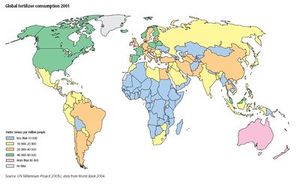
(Source: UN Millennium Project 2005c, data from World Bank 2004)
Increasing agricultural production is widely acknowledged as a priority area for Africa, and essential in addressing food security problems, human vulnerability to environmental change, and achieving Millennium Development Goal (MDG) 1 to eradicate extreme poverty and hunger. One key challenge, as discussed in Land resources in Africa and Genetically modified crops in Africa, is the problem of land productivity and related low crop yields. In Africa, low productivity is a factor of the ecological reality and low investment in agriculture. Productivity is further threatened by human-induced changes and natural processes; key among these are climate change and variability, and invasive alien species.
Synergistic growth in the chemicals industry could have positive spin-offs for the development of agriculture. The use of agricultural chemicals, including fertilizers, herbicides, fungicides and insecticides can help improve yields, for example. Chemicals may also be beneficially used in livestock production as vaccines and in animal feed. Chemical use in the African agricultural sector is likely to increase as a result of the growing commercialization as well as the growing focus of development agencies on improving yields of small farmers. In Africa the per capita use of fertilizers is relatively low, as shown in Figure 1. The UN Millennium Project notes the need for small farmers to be supplied with soil nutrients and other related technologies, while at the same time recognizing that there must be increased use of sustainable agricultural practices if natural assets are to be preserved. Environmentally-friendly options may include the use of nitrogen-fixing plants and agroforestry, as well as the application of bio-fertilizers, such as animal waste and plant mulch.
Agricultural extension and aggressive corporate marketing have contributed to increased use of agricultural chemicals. In many places, small farmers under pressure to engage in the market, produce improved crops and increase yields have abandoned traditional, more environment-friendly, practices. This may have a range of negative environmental impacts including on soil and water quality. In Africa, despite the poor levels of comparable data over the last five decades, trends indicate an increase in the concentration of nitrates (Nitrogen) and phosphates at river mouths, this mirrors the trends in developing economies elsewhere including in Southeast Asia. Inappropriate fertilization and irrigation practices can result in salinization and acidification of soil, and in Africa, chemical-related soil degradation affects 51 million hectares (ha) of land, with about 40 million of these being nutrient-deficient and salinity affecting about 6 million ha.
Food security and pest management
As discussed elsewhere in this report (Land resources in Africa and Genetically modified crops in Africa) the challenges of achieving food security are complex and require a multidimensional approach. In many parts of Africa, pests pose a significant threat with locust invasions, for example, repeatedly threatening food security especially in Western Africa (Western Africa and land resources).
Chemicals are an essential aspect of pest management and Africa has relied extensively on the use of persistent organic pollutants (POPs) including some of the chlorinated pesticides (Box 1). However, it is important for Africa to begin to look for alternatives to many of the highly toxic chemicals it uses in pest control. Chemical use is a costly option. The highly toxic chemicals used to deal with locust plagues, for example, not only affect locusts, but also humans, animals, including livestock, and the environment. Apart from these dangers, spraying also requires huge logistical resources, which many of the poor countries most affected by locusts cannot afford. Additionally, storage of chemicals and the re-use of chemical containers also threaten human health.
Termites threaten infrastructure and food security
In many African countries, termites present a huge problem, threatening both infrastructure and food production and thus directly affecting human well-being and the potential for economic growth. Termites also pose significant threats to other goods including household furniture, paper products, many synthetic materials and food items. Globally, each year, hundreds of thousands of structures (bridges, dams, decks, homes, retaining walls, roads, utility poles, and underground cables and pipes) require treatment for the management of termites.
Africa has high termite diversity of about 1,000 different species, reflecting its topological and climatological diversity. In particular, the tropical forests of Central Africa and all of the countries in Southern Africa contain diverse and abundant termite fauna. Genera infesting wooden structures include Reticulitermes, Coptotermes, Psammotermes (Family Rhinotermitidae), Anacanthotermes (Hodotermitidae), and several species of Kalotermitidae. Mound-building species occur throughout most of the African landscape. Some species have been transported over much of Africa due to commerce and nomadic migration.
Some species directly threaten agricultural systems, as shown in Box 2. There are approximately 20-50 damaging termite species in savannah and forest ecosystems in the family Termitidae. The majority of species feed on plant material, living or dead, dung or soil rich in organic material. The greatest pest potential exists within the subfamily Macrotermitinae, which has a symbiotic association with the fungus Termitomyces . The most economically important genera throughout Africa are Macrotermes, Odontotermes, Pseudacanthotermes, Ancistrotermes and Microtermes. These differ characteristically in their biology and mode of attack:
- Macrotermes spp. build large mounds from which they forage outwards for distances up to 50 m in galleries. They attack plants at the base of the stem, ring-barking or cutting them through completely.
- Odontotermes spp. build both subterranean and epigeal nests. Damage is due to feeding either under soil sheeting on the outer surface of the plants or on the roots.
- Microtermes spp. and Ancistrotermes spp. have diffuse subterranean nests and attack plants from below ground by entering the root system and tunnelling up into the stem, hollowing it out and frequently filling it with soil.
Termite control measures vary considerably across Africa, and range from manual removal of queens and nests by hand, to soil applications (topical and injection) with termicides, to baiting. For termites that attack dry wood, fumigation with methyl bromide and topical and subsurface chemical injections are the standard practice. Chlordane is widely used. The costs associated with chemical use are extensive and include:
- health costs (treatment, working days lost by those ill and by those taking care of the ill);
- costs of exceeded residue levels (leaving a proportion of produce unfit for marketing);
- costs related to pesticide resistance and resurgence;
- pesticide-related research;
- costs of pesticide quality control and residue monitoring;
- costs of pesticide regulation; and
- costs of pesticide-related extension.
Alternatives to chemical use vary in efficiency depending on climatic factors and the species. It is imperative given the agreements under the Stockholm Convention on Persistent Organic Pollutants (Stockholm Convention) for countries to begin to develop management systems based on alternatives. Alternatives include improved building practices such as building design (site preparation, construction and regular building maintenance and inspections), physical barriers, using preservative treated timber, space fumigation, baiting systems, thermal and biological control, and safer chemicals. In general, however, changing from one chemical to another is not a long-term solution.
Complete prevention and eradication of termites is not a plausible management objective; instead the focus should be on better management, and on reducing the costs to people and the environment. Successful termite management is a process that includes the talents of construction, pest management, and building management professionals. Lastly, termite management systems are most successful and least expensive when implemented pre-construction. Conversely, they are often less successful and more expensive post-construction.
Control of diseases
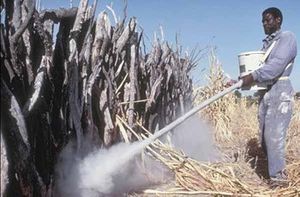
Chemicals are widely used in the control of diseases. Persistent organic pollutants (POPs) are used in vector control for diseases such as malaria. Pesticides such as dichlorodiphenyltrichloroethane (DDT) are used primarily to control malaria as well as in the veterinary sector to control plague-transmitting fleas and trypanosomiasis transmitting tsetse flies. The use of these chemicals presents special challenges for Africa; the negative environmental impacts need to be weighed against the gains made from disease control.
The high incidence of some diseases is not just a challenge in relation to mortality levels, but also threatens economic prospects. Malaria for example is still a primary killer in Africa (see Figure 2 for populations at risk). In 2001, there were an estimated 270-480 million cases per year with approximately 900,000 people dying from the disease annually. Malaria has slowed annual economic growth by 1.3 percent, imposing a loss of US$12,000 million on the region per year. Despite the environmental threats it poses, DDT has been the most cost-effective and efficient way of controlling malaria. This is the main justification for its continued use and its exemption under the Stockholm Convention until such time that alternatives are found. South Africa’s experience is illustrative. When South Africa stopped using DDT in 1996, the number of malaria cases in the KwaZulu-Natal province rose from 8,000 to 42,000 by 2000. South Africa tried various alternatives but they proved less effective. Since reintroducing DDT, it has been able to reduce the number of deaths in the province to less than 50 per year.
However, while DDT is important for disease control, there are concerns that its continued use constitutes a health risk (Health effects of DDT, DDE and DDD) especially for countries with limited chemical management infrastructure. DDT has also been found to bioaccumulate especially in aquatic species including crayfish, prawns and fish, and in this way poses a further threat to human health. With climate change, the incidence and range of malaria is predicted to increase potentially increasing the need for the continued use of this highly toxic chemical.
Freshwater systems and access to safe water
Pollution places freshwater systems at risk and threatens the availability of safe water for human consumption, by disrupting essential ecosystem services. Ecosystems provide effective mechanisms for cleansing the environment of wastes; this service is now overtaxed in many settings, leading to local and sometimes global waste accumulation. Well functioning ecosystems absorb and remove contaminants. For example, the role played by wetlands in maintaining freshwater quality by the removal of excess nutrients is well-established. As the Millennium Ecosystem Assessment (MA) notes, these systems are under threat and this poses new challenges for management:
- Where excessive wastes are discharged into ecosystems, ecosystems are unable to cope and waste treatment technologies are required to restore or preserve ecosystem balance, and thus reduce or eliminate the risks to human health.
- Recycling can be an important environmental management strategy, however where waste contains POPs or heavy metals, recycling can lead to the accumulation of these pollutants and increased human exposures through food and water
Meeting water needs is a priority for Africa, and countries have agreed, in terms of the MDGs and the Africa Water Vision 2025, to increase the number of people with access to safe water (Freshwater resources in Africa). The lack of safe water poses a major threat to human well-being. In 2002, 303 million people across Africa still did not have access to safe water. The lack of access to safe water is a product of many factors including increasing pressure on limited resources by population growth and a lack of priority given to this issue. Access to safe water varies within countries, with poor and rural people being at the greatest disadvantage. For example, in Congo, 77 percent of city and town dwellers have access to safe drinking water but only 17 percent of rural inhabitants do. About 627,000 children die annually from diarrheal illnesses, related to a large extent to unsafe drinking water.
Inorganic chemical compounds and POPs in food and water present risks to people. Such contamination may be the result of natural processes (as in the case of fluoride or arsenic (Health effects of arsenic) contamination of water sources) or from human releases of toxic chemicals into the environment (through, for example, pesticide use). In small quantities fluoride is good for teeth, however in high concentrations it destroys teeth and accumulates in bones resulting in crippling skeletal damage. Because they are still growing, children are at highest risk. As of 2004, cases of dental and skeletal defects have been reported in Ethiopia, Eritrea, Kenya, Niger, Nigeria, South Africa, Sudan, Tanzania and Uganda.
Inorganic nitrogen pollution of inland waterways has more than doubled globally since 1960 and increased by a factor of over ten for many industrialized parts of the world. As already noted, pollution impairs the ability of ecosystems to provide clean and reliable sources of water. Deterioration of freshwater quality is magnified in cultivated and urban systems (due to high use and high pollution sources) and in dryland systems (due to high demand for flow regulation and absence of dilution potential). This is particularly significant for Africa, given the extent of drylands within the region. There is also an increasing presence of pharmaceutical products or residues in the environment from sewage and solid waste discharges, however the health risks these chemicals pose have not yet been quantified.
In addition to the threats posed by pollutants, water quality is also affected by pathogens, which fall into three general categories: bacteria, viruses and parasitic protozoa. Bacteria like Vibrio cholerae, Salmonella typhii and several species of Shigella routinely inflict serious diseases such as cholera, typhoid fever, and bacillary dysentery, respectively. Chemicals can play an important role in the treatment of water against such pathogens. Given the general non-availability of piped water to homes people have to collect water from shared wells, rivers or community access points. Many people are forced to use old containers for collecting water. Due to a lack of awareness, agricultural chemical containers are often used and illness can often result.
Chemical exposure
Toxic chemicals can cause a variety of adverse health effects. Toxic substances such as arsenic, cadmium, lead and sulphuric acid contaminate water and soil, and affect human health. More than 50,000 tonnes of obsolete pesticides have been stockpiled in Africa contaminating tens of thousands of tonnes of soil. These obsolete pesticides represent a major threat for human health. Low-level exposure to some chemicals present in industrial effluent or used as pesticides, such as poly-chlorinated biphenyls (PCBs), dioxins, and POPs such as Dichloro-Diphenyl-Trichloroethane (DDT), may cause Endocrine disruption, undermining disease resistance and affecting reproduction. They are also responsible for more acute health impacts, including poisoning. Persistent organic pollutants cause a range of health problems, even at low levels of exposure, including reproductive and developmental disorders, damage to the immune and nervous systems, and a range of cancers. Exposure during key phases of foetal development can be particularly damaging. Heavy metals pose serious threats, particularly to children and during foetal development. In Africa, between 18 and 24 percent of children have concentrations of more than 10 micrograms per decilitre (?g/dl) of blood. Box 3 gives an overview of problems associated with lead contamination, with a special focus on mining in Central Province in Zambia.
With growing production and consumption, and new economic development, the risks associated with chemical use will increase. This will place new demands on Africa’s chemical management institutions. In addition to intended environmental releases, there is also an increased risk of accidental releases and chemical-related accidents. Examples of hazardous incidents include the misuse of mercury in small-scale mining, PCBs in the electricity sector, DDT in the health sector and pesticides in the agricultural sector.
These chemicals pose serious risks that are exacerbated by the lack of adequate access to information regarding safe handling, use and disposal of chemicals. See for example the risks associated with Lead in Box 3 and DDT in Box 4. Poverty and lack of access to information may exacerbate these negative impacts. In the context of scarce resources, chemical containers are often re-used by rural people for household purposes including the collection of water and can result in poisoning. More than 11 million poisoning cases by pesticides occur annually in Africa, yet few African countries have specialized poison centres. In 2004, only ten African countries had poison centres, and none had more than five. Further, since agriculture is the main employer for women and children, they are the most exposed to chemical risks. In many cases, both for subsistence and commercial farming, producers and workers have insufficient knowledge about the health risks posed by chemicals and therefore fail to take adequate protective measures.
Natural resource use and adverse environmental impacts
The chemical industry is dependent on raw materials including coal, gas, air, water, minerals and genetic resources. With increased production the demand for these resources will also increase. Promoting sustainable use of natural resources and the adoption of cleaner production must, therefore, be a focus of industrial management. The industry itself is increasingly recognizing this through, for example, environmental standards adopted by the International Standards Organization (ISO). Consumers are also increasingly demanding such integrated approaches.
Industrial processes require large amounts of water and energy. In non-OECD countries, the use of energy for chemical production has increased. Given the shift of the industry to developing countries there has also been a shift in the share of energy use in these countries from 20 percent in 1971 to 43 percent in 1998. Increasing energy use also results in increased emissions of greenhouse gases (GHG) that contribute to climate change (see Atmospheric resources in Africa). Specific threats posed by climate change and variability are discussed in the Human dimension of development in Africa (health), and Land resources in Africa. The chemicals industry accounts for one-quarter of the total releases of CO2 from industrial sector operations, although this amounted to only 4 percent of the emissions from all sources in 1997.
Impacts on biodiversity
While many environmental contaminants degrade quickly in the environment, others:
- Are released in quantities, concentrations or under conditions so that elevated concentrations are sustained in the environment; and
- Have a combination of physical and chemical properties so that, once released to the environment, they degrade very slowly and remain present in the environment and organisms for many years or even decades, even when released in relatively small quantities. These chemicals are said to be persistent.
Persistent chemicals can, through natural environmental processes, be distributed over long distances, leading to regional and global contamination. Many of these enter the food chain and are retained in organisms at concentrations higher than those in food and water – a process known as biomagnification. These substances are said to be bioaccumulative. In recent decades, there has been increased attention paid to addressing the risks posed by substances that are persistent, bioaccumulative and toxic (PBT), POPs and some metal compounds. However, many other chemicals, thought to be less harmful, are having significant negative impacts on biodiversity and human health.
Chemical pollution compromises the integrity of ecosystems, and thus directly threatens biodiversity. The increased discharge of nitrogen compounds from fertilizers in rivers can result in the eutrophication of surface and coastal seawater, and, in extreme cases, a state of complete oxygen depletion (anoxia) which severely affects the ecosystem and results in fish deaths. Excessive use of chemical fertilizers also contributes to the degradation of land through salinization, thus limiting agricultural production potential.
Chemicals pose many threats to wildlife. Research over many decades has demonstrated the adverse and often irreversible effects of POPs, PCBs, and heavy metals on the endocrine systems, especially reproductive hormones. These disruptions (Endocrine disruption) are now understood to have much more extensive effects including on thyroid and pituitary systems. Neurological damage is a common feature of chemical poisoning and many chemicals are carcinogenic. With the increase in chemical use these impacts on wild animals have increased. Chemicals previously thought to be safe, but with negative impacts on wildlife include:
- Perfluroocatanes – these are widely used as surfactants and emulsifiers. They are used as water protectors for carpets, textiles, leather, food packaging and other containers. They are also used in the production of shampoo and dental cleaners, and as lubricants for bicycles, tools and zips.
- Phtalates – this group of chemicals are used as softeners in a variety of plastic products including in medical equipment, building products, car products, upholstery, clothing and children’s toys.
- Phenols – these are used in the production of polycarbonate plastics that are widely used in electrical appliances.
- Polybrominated flame retardants – these are widely used in furniture, building materials and clothing.
Increasing human consumption and poor waste management are key factors in this growing threat to biodiversity.
Further reading
- Buccini, J., 2004. Global Pursuit of the Sound Management of Chemicals. World Bank,Washington, D.C.
- ECA, 2005. Economic Report on Africa 2005: Meeting the Challenges of Unemployment and Poverty in Africa. Economic Commission for Africa, Addis Ababa.
- Gordon, B., Mackay, R. and Rehfuess, E., 2004. Inheriting the World: the Atlas of Children’s Environmental Health and the Environment. World Health Organization, Geneva.
- Groombridge, B. and Jenkins, M., 2002. World Atlas of Biodiversity: Earth’s Living Resources in the 21st Century. University of California Press, Berkeley.
- IDRC (undated). africa.doc IDRC support for medicinal plant research. Regional Profile: Africa Sustainable Use of Biodiversity Program Initiative. Medicinal Plant Research Fact Sheet Series 2 of 5. International Development Research Centre, Ottawa.
- IPEN, 2002. The IPEN Arusha Declaration on the Elimination of Persistent Organic Pollutants in African Countries, Arusha, Tanzania, 19 July 2002. International POPs Elimination Network.
- IRIN, 2004. The Eighth Plague:West Africa’s Locust Invasion – Chemical warfare against locusts and its dangerous side effects – Methods of pest control. The United Nations Integrated Regional Information Networks.
- Kanali, A.G., 1998. Pharmaceutical Industry. Northeastern Illinois University
- MA, 2005. Ecosystems and Human Well-being: Health Synthesis. Millennium Ecosystem Assessment.World Health Organization, Paris.
- MA, 2006. Ecosystems and Human Well-being: Current State and Trends. Volume 1. Millennium Ecosystem Assessment. Island Press, Washington.
- Mörner, J., Bos, R. and Fredrix, M., 2002. Reducing and eliminating the Use of Persistent Organic Pollutants: Guidance for sustainable activities for effective pest and vector management. Inter-Organization Programme for the Sound Management of Chemicals, Geneva.
- NEPAD, 2002. Comprehensive Africa Agriculture Development Programme (CAADP) – New Partnership for Africa’s Development. Food and Agriculture Organization of the United Nations, Rome.
- NEPAD, 2003. Action Plan for the Environment Initiative. New Partnership for Africa’s Development, Midrand.
- TWAS, 2002. Safe Drinking Water: The Need, the Problem, Solutions and an Action Plan, Report of the Third World Academy of Sciences. Third World Academy of Sciences, Trieste.
- Tren, R. and Bate, R., 2004. South Africa’s war against Malaria: lessons for the developing world. Policy Analysis No. 513. Cato Institute, Washington, D.C.
- UN Millennium Project, 2002-2006.
- RBM/WHO, 2003. Malaria in Africa. Roll Back Malaria/World Health Organization.
- UNEP, 2006. Africa Environment Outlook 2.
- UNEP/FAO/Global IPM Facility Expert Group on Termite Biology and Management, 2003. Finding Alternatives to Persistent Organic Pollutants (POPS) for Termite Management. United Nations Environment Programme / Food and Agriculture Organization of the United Nations / Global Integrated Pest Management Facility. United Nations Environment Programme.
- WHO/AFRO, 2001. Progress in Rolling Back Malaria in the African Region. Malaria, Liaison Bulletin of the Malaria Programme WHO/AFRO, 4 (4). World Health Organization / Africa Regional Office.
- WHO and UNICEF, 2004. Meeting the MDG Drinking Water and Sanitation Target: a Mid-term Assessment of Progress. World Health Organization and United Nations Children’s Fund.
- WWF, 2004a. wildlife.org/toxics/pubs/causesforconcern.pdf Causes for Concern: Chemicals and Wildlife. WWF-World Wide Fund for Nature, Gland. (prepared by Brown,V.)
- WWF, 2004b. Wildlife at Risk: Emerging Chemical Threats. WWF-World Wide Fund for Nature.
|
|
| Disclaimer: This article is taken wholly from, or contains information that was originally published by, the United Nations Environment Programme. Topic editors and authors for the Encyclopedia of Earth may have edited its content or added new information. The use of information from the United Nations Environment Programme should not be construed as support for or endorsement by that organization for any new information added by EoE personnel, or for any editing of the original content. |

